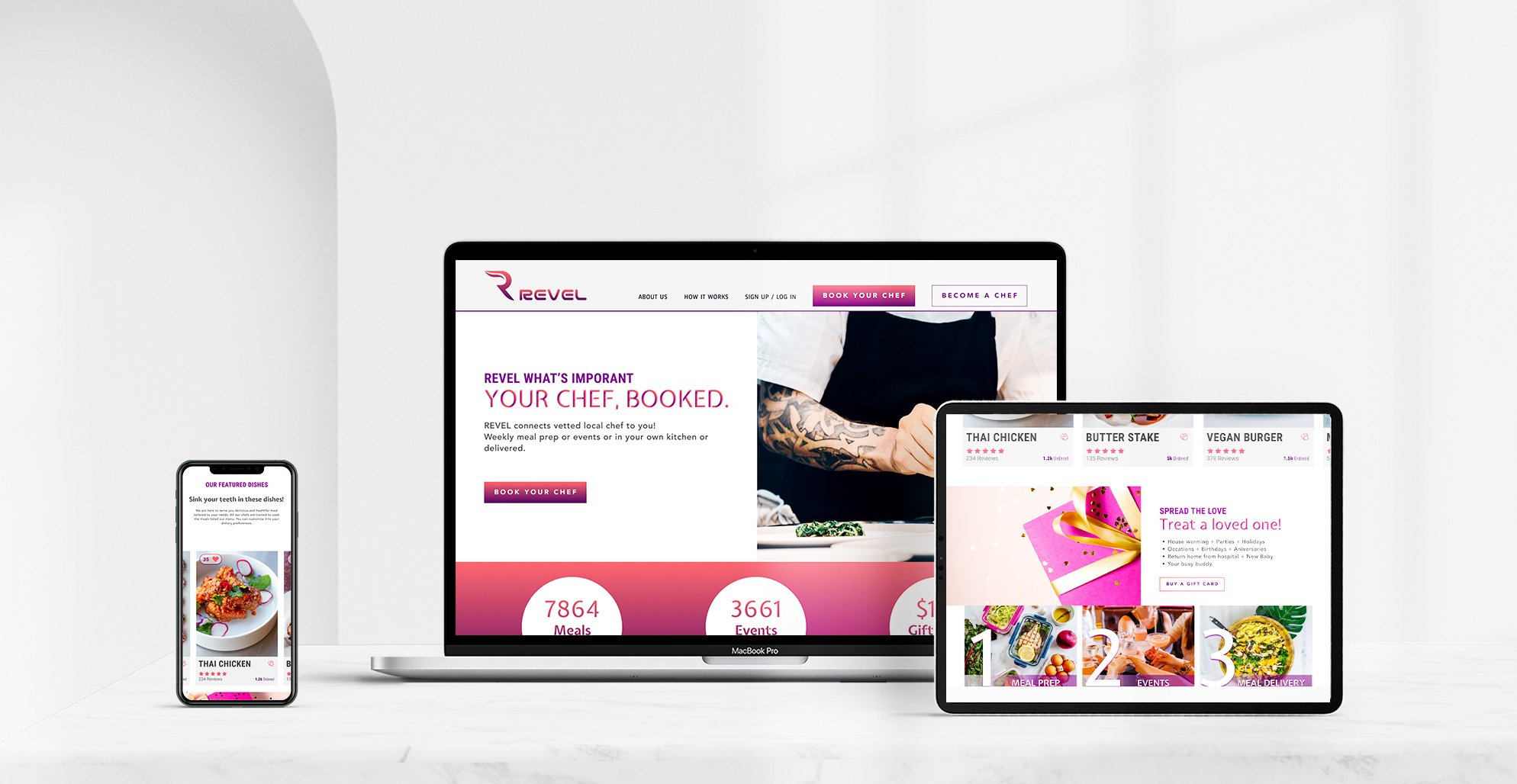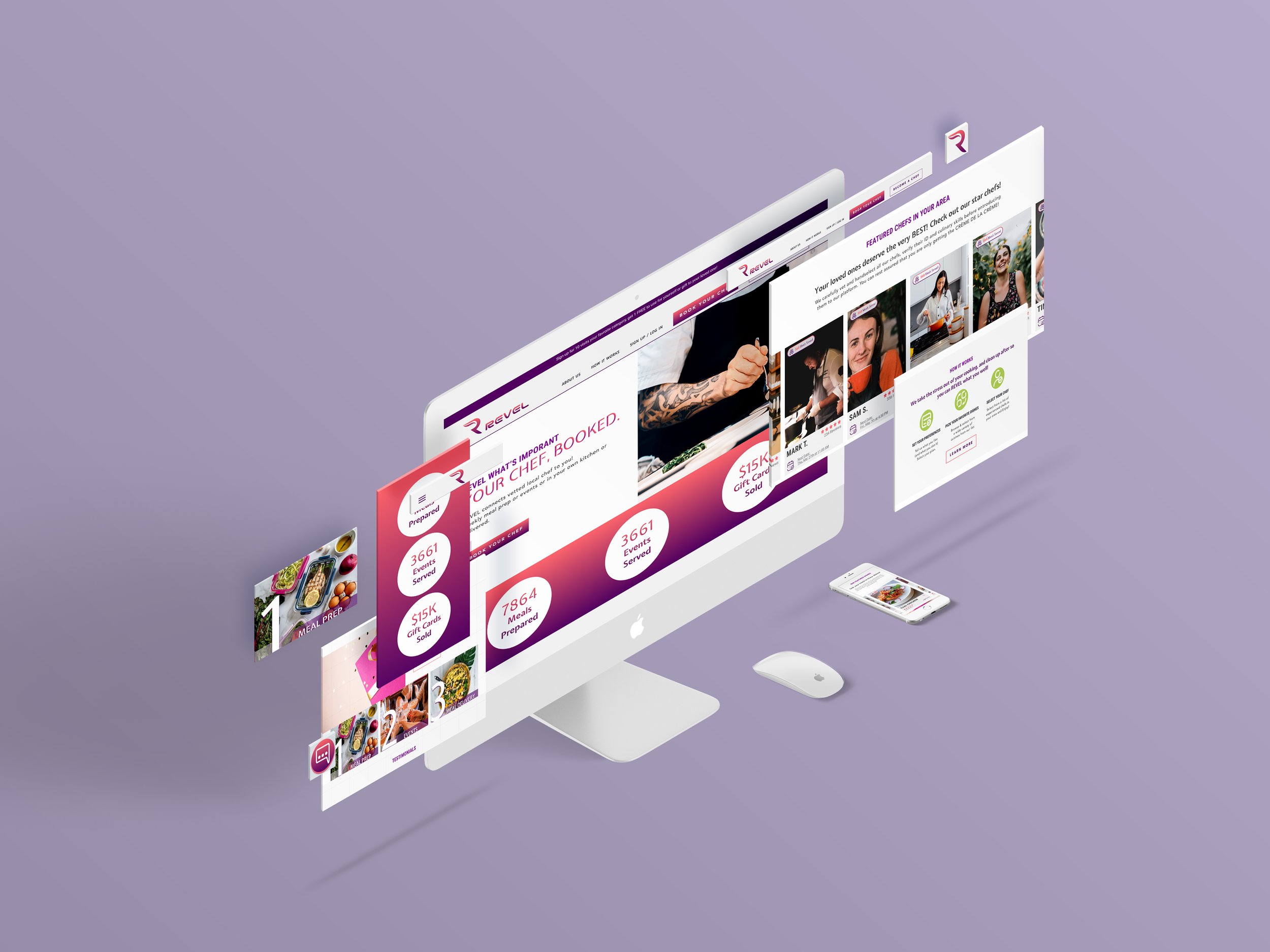
REVEL Your Chef. Booked.
Responsive Website
Trusted , personal chef booking platform, connecting affordable local chefs with families for everyday meals prepared either in your own kitchen or delivered.
My Role: UX & UI / Branding / Responsive Website
Designed REVEL personal chef booking website conducted user research, performed market analysis, synthesised information, defined scope, setup responsive website, led user testing, iterated, establishing trust, built confidence, and attract more users.
Duration: 3 weeks
Tools Used:
Design / Prototype: Figma, Photoshop, Illustrator
Your Chef. Booked.
REVEL is revamping its branding, boosting trust, attracting new clients and clarifying its “How It Works” page.
Affordable-Luxury
Attainable Indulgence
Convenience

Understand & Empathize
The two sides to a coin.
Business
• Looking to grow the business, attracting more VC funding.
• How do we stand out and attract more clients?
• How can we build trust with new consumers?
Client
• “How it works” message was unclear.
• Can the food be delivered?
• Safety of having a stranger cooking in my kitchen.
User Group
Who are the
“Sandwich
Generation?”
REVEL users belong to the “Sandwich Generation,” they are well educated, busy professionals, with one or more dependents.
They are part of a dual income household, or single parent.
Health Conscious
Highly educated, health conscious group appreciates health benefits of homemade meals.
Busy
Busy lifestyles- balancing work, education, personal responsibilities as well as pursuit of hobbies.
Customization
Health, personal or religious preference inform needs for customized menu.
Problem
Health and wellness are essential to “Sandwich Generation.” Family meal are highly valued. This generation covets quality time with family. As high achievers with their professional and academic pursuits, balancing quality of life can be challenging. A number of products and services are available, mostly premade packaged meal or takeout. These products lack freshness and “human touch.”
Opportunity
Creating a trusted platform, REVEL, connecting local chefs with the “Sandwich Generation” feeding loved ones homemade meals. Elevate clients’ quality of life, gain valuable leisure time, eating well, and fulfilling customized dietary needs for the entire family.
User Centered Design
Identifying & defining needs based on each user group
While 50% of researched participants selected occasional usage, I decided to categorize them as secondary user group. From a business and frequency of usage standpoint, it’s logical to Identify 35.7% “Twice a week” group as my primary users.
Primary User Persona
THE REGULAR is based on the 35.7% “Twice a week” group. Even though they are not the majority, it is important to prioritize this group from a business and frequent usage perspective.
Secondary User Persona
THE OCCASIONAL is based on the 50% “Special Occasions ” group. Even though they were the majority, considering infrequent usage and REVEL’s business model, they were categorized as secondary users.
Digging Deeper
After initial interview with stakeholder and primary users, I found a few affinity patterns:
Comfort levels varies with “having a stranger in my kitchen.”
The question “Who’s getting groceries?” kept popping up
Conflicting findings on browsing & search preferences
by Chef
by Dish
by Availability
The following surveys were conducted to gauge user sentiment, discern true preference to guide strategic and design solutions that resonates with the user and the platform.
How might we build trust, boost user confidence?
39.3 % DO NOT feel comfortable with a stranger in their kitchen.
25 % had mixed feelings and reservations.
Follow up interviews revealed “success stories,” “client testimonials”, and “social proof” can influence their decisions.
Solution: Identify opportunities to boost user confidence, with numbers, social proofs and client reviews at a glance.
Should we simplify current process and offer a seamless service?
60.7 % Prefers chefs do the grocery shopping
Time Saving
Convenience
28.6% Maybe
They may already have some items
10.7% Prefers buying their own groceries
Brand preferences
Cost
Solution: Taking this survey and interview with personal chefs into consideration, weighing pros and cons, led me to include grocery shopping as part of the service to ensure success rate and focusing on providing seamless service to clients.
Numbers DO lie!
When users lack clearly defined parameters, it is very hard for them to truly know what they want. Stakeholder interview suggested leading the search with cuisines isn’t ideal.
Users did not want to spend time looking up the cuisines if they might not like the chefs.
There’s also no point looking up the chefs only to find that they are unavailable on days that work for them.
To investigate deeper I conducted two separate user survey and yield two different results to the same question.
The first graph, generated from users without any preconceived information, it suggests 35.7% prefer leading their search by cuisine.
The second survey taken with a different group of participants, utilizing pre-survey group discussion mentally running through various booking steps, resulted in establishing “date, time & location,” followed by chef then cuisine.
Lessons learned
Users may not know their true preference based on the limited information they have. In this case, the research calls for prior parameters to be established.
Multiple research methods may be needed for certain scenarios.
Don’t take the numbers at face value.
Critical thinking and problem solving are essential when reviewing the numbers.
Solution
Establish approximate location first.
Location based “Featured” suggestions e.g. “Featured Local Chefs.”
Favored dish with social proof.
SCOPE
-
1- Update Branding
Introducing excitement and a dash of flamboyant fun to the branding and UI.
*
Branding Make-Over
Fun & Interesting Icons
Bright Colors
-
2- Establish Trust
Build trust with successful key numbers, reviews and social proofs.
*
Number of meals served
Featured Local Chefs
Social Proof
-
3- Clarifying "How It Works"
Research revealed users unclear about services offered.
*
“How it works” Homepage/Detail Page
Services Offered
FAQ

Building IA Structure
Built strategic tiles for homepage as primary development, “How It Works,” secondary. It takes less than 30 seconds for users to gauge a brand through its website. Homepage sets the tone, establishing credibility, reflecting brand’s direction and sending message resonating with user needs.
Sketches for info tiles

Details Homepage
Number Callouts
User interview and secondary research indicates number callout boosts confidence levels and influence decision making.
Featured Chef Card
With just a quick glance, users can have a good idea about the chef and see their next available date.
How It Works
Clear and simple How It Works and a button that will take users to detailed page with FAQs.
Favorite Dishes
Favorite dish shows how many people favored and order the dish.
GIft Card
50% of the users considered this service for special events. It is important to offer gift cards along with suggested occasions.
List of services offered with a few descriptions.
Video is being created…
With more time, I want explore…
“Booking A Chef” flow
I want to research, think and plan “Book a Chef” flow.“Contributor” Menus, tips page
Utilizing Web 3, involving contributors and content creators to post time saving tips and menus to engage more users.
Key takeaways…
• Responsive layout grid, planning and execution for translation to tablet and phone.
• Be discerning of the tools used for validation:
Review user research answers with a grain of salt, sometimes, users does not know what they want. It is UX/UI designer job to validate, verify and present solutions that elevates the user experience.
• Schedule regular check-ins:
Review and iterate the project as often as possible.






















